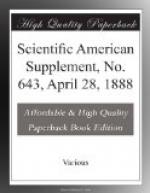The use of concrete is becoming more and more general for foundation works. The desideratum hitherto has been a perfect and at the same time an economical mixer. Concrete can be mixed by hand and the materials well incorporated, but this is an expensive and man-killing method, as the handling of the wet mass by the shovel is extremely hard work, besides which the slowness of the method allows part of a large batch to set before the other is mixed, so that small batches, with attendant extra handling, are necessary to make a good job. Mixers with a multiplicity of knives to toss the material have been used, but with little economical success. Of simple conveyers, such as a worm screw, little need be said; they are not mixers, and it seems a positive waste of time to pass material through a machine when it comes out in little better shape than it is put in. A box of the shape of a barrel has been used, it being trunnioned at the sides. The objection to this is that the material is thrown from side to side as a mass, there being a waste of energy in throwing about the material in mass without accomplishing an equivalent amount of mixing. Then a rectangular box has been used, trunnioned at opposite corners; but here the grave objection is that the concrete collects in the corners, and after a few turns it requires cleaning out, the material so sticking in the corners that it gets clogged up and ceases to mix.
The writer has just protected by letters patent a machine, in devising which the following objects were borne in mind:
1st. That every motion of the machine should do some useful work. Hitherto box or barrel mixers have gone on the principle of throwing the material about indiscriminately, expecting that somehow or other it would get mixed.
2d. That the sticking of the
material anywhere within the mixer
should be obviated.
3d. That an easy discharge should be obtained.
4th. That the water should
be introduced while the mixer
revolves.
With these desiderata in view, a box was designed which in half a turn gathers the material, then spreads it, and throws it from one side to the other at the same time that water is being introduced through a hollow trunnion.
It is also so constructed that all the sides slope steeply toward the discharge, and there is not a rectangular or acute angle within the box. A machine has now been worked steadily for several weeks, putting in the concrete in the foundations of the new Jackson Street bridge in this city, by General Fitz-Simons. The result exceeds expectations. The concrete is perfectly mixed, the discharge is simple, complete and effective, and at the same time the cost of labor in mixing and placing in position is lessened by 50 per cent. as compared with any known to have been put in under similar circumstances.—Jour. Association of Engineering Societies.




